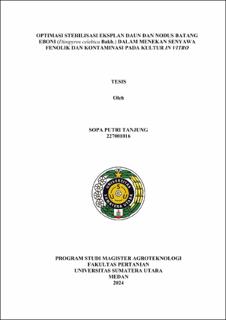| dc.description.abstract | Ebony is an endemic and rare tree that grows naturally on the island of
Sulawesi, also known as black wood. One of the efforts to maintain its
sustainability is to provide good-quality seedlings through the in vitro culture
method. but there is browning, and contamination of in vitro culture explants
inhibits the regeneration initiation efforts of these ebony explants. This research
aims to obtain the most optimal method of sterilization of ebony leaf and stem
node explants and to know the types of contaminants that appear to improve the
success of ebony regeneration initiation in vitro. This research was compiled
using a non-factorial, completely randomized design (CRD) with 5 types of
treatments on leaf explants and 3 types of treatments on stem node explants using
various sterilization methods by observing the percentage of sterile and notbrowning
explants, the percentage of explant browning, and the percentage of
explant contamination. In addition, descriptive analysis was carried out on the
research by observing the macroscopic and microscopic characters of microbes.
The research results showed that the D3 treatment (Fungicide + Tween 20,
Bactericide + Tween 20, NaOCl 10%, NaOCl 20%, NaOCl 30%, Alcohol 70%)
leaf explant gave the best results on the percentage of sterile and non-browning
leaf explants at 100%, while in the stem node explants, the N3 treatment
(Fungicide, Bactericide, 70% Alcohol, NaOCl 25% + Tween 20, Ascorbic Acid)
gave the best results on the percentage of sterile and non-browning explants at
33%. The types of contaminants that appear in leaf explants are thought to be
Mucor sp fungi, and the types of contaminants that appear in stem node explants
are thought to be Mucor sp, Rhizoctonia sp, and Aspergillus sp fungi, as well as
Bacillus sp, Pseudomonas sp, and Staphylococcus sp bacteria. | en_US |


